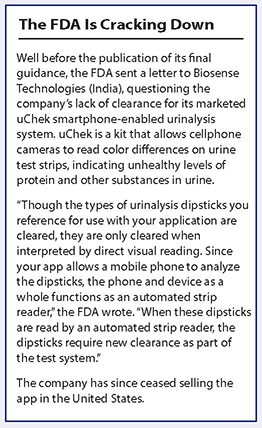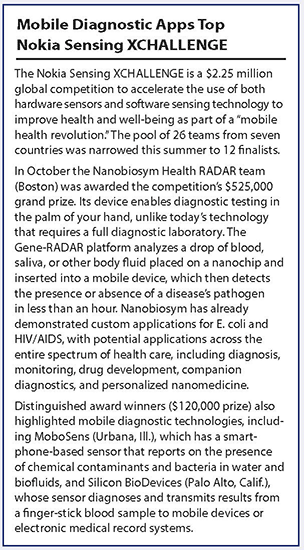Integrating the use of mobile devices such as smartphones and tablets into clinical care, or mobile health (mHealth), has the potential to transform the practice of medicine, allowing for monitoring of remote patients and encouraging a significantly more active role for patients in their own health care. Experts envision mHealth will drive an evolution of the health care system that will include real-time, decentralized monitoring of chronic conditions, as well as the ability of patients to run remote diagnostics off of their mobile devices.
Mobile applications that allow for better management of chronic conditions through the automatic logging and transmission of testing results to health care providers are already in use, and the U.S. Food and Drug Administration (FDA) recently released its final guidance on the regulation of medical apps. This is a move the mHealth industry applauds, saying it adds needed clarity as to what apps are in fact medical devices and it should hasten development and adoption of mobile health apps, including those for diagnostic purposes.
The Future of mHealth
The potential of diagnostic apps is limited only by how well the data they generate are integrated into clinical workflow. Some experts envision a day where the combination of mobile phone cameras, sensors, and cloud computing will allow patients to run a gamut of basic laboratory tests right from their smart devices, allowing patients to not only access their health information for better wellness management, but also increasingly generate the data needed for clinical decisionmaking. Continuous, real-time health readings will supply care providers with improved insight, instead of just single point-in-time measurements obtained in traditional outpatient care.
“We are getting away from diagnosis as something you go to to get and away from [results] being something someone else has information about,” Joe Smith, M.D., Ph.D., chief medical officer of applied medical research organization West Health, tells
DTET. “We are moving towards an ambient mode where information is constantly aggregated and insight from this will be constantly accessible. We are seeing a democratized framework for health care. Baby boomers, as patients, are not OK with the system of doctors and offices and regulators acting as gatekeepers. They are interested in access to information themselves.”
Rapid growth of mHealth adoption is expected to continue worldwide. A widely quoted March report by mobile device consultants Research2Guidance says that the mobile health market may reach $26 billion by 2017 and that 500 million smartphone users worldwide will be using a health care app by 2015. Estimates vary, but industry experts believe that there are close to 50,000 mobile health applications currently available for purchase in app stores, including medical apps as well as fitness and nutrition guidance and tracking. However, increasingly mHealth products are emerging that actually turn a smartphone or tablet into a medical device capable of performing electrocardiography (ECG) monitoring, urinalysis, and blood-based infectious disease diagnosis and tracking.
“Everybody recognizes mobile is reality. Apps will move from a nicety to a necessity,” says Drew Hickerson, assistant general counsel and senior director of business development at Happtique, a mobile distribution platform that enables discovery and display of health apps and digital content for health care providers. “Even today people leave home without their wallets, but not their mobile phones. Apps are convenient, approachable, and increasingly used for everything from ordering groceries to managing finances. Health care has always been behind other industries, but other conservative markets like financial services are employing mobile apps to empower consumers. This will happen in health care too.”
mHealth Regulation and the FDA
Providers and developers have been seeking clarification as to what mobile apps are considered medical devices and are subject to regulation. The FDA released its final guidance in late September and said that it will only regulate a small portion of the vast number of mobile health apps. The guidance indicates the FDA intends to take a tailored, risk-based approach in which it will exercise enforcement discretion (meaning it will not enforce its authority) for mobile apps that pose minimal risk to consumers, such as those that merely allow patients to log test results but do not provide specific treatment or treatment suggestions.
“This is a classic case of what’s old is new again,” says Chris Bergstrom, chief strategy and commercial officer at WellDoc, an mHealth developer of BlueStar, an FDA cleared prescription-based platform that provides real-time coaching to patients with type 2 diabetes. “The published guidance is consistent with the long-standing polices of regulated medical devices, even before the terms
mHealth and
digital health came to be. Meaning if a mobile product diagnoses, treats, or mitigates a disease or is an accessory to a medical device then it will be regulated. In other words, no surprises.”
The FDA will focus its regulatory oversight on a subset of mobile medical apps that present a greater risk to patients if they do not work as intended. These apps fall into two categories—those that are used as an
accessory to a regulated medical device (connects to such a device “for purposes of controlling the device(s) or displaying, storing, analyzing, or transmitting patient-specific medical device data”) and those that
transform a mobile platform into a regulated medical device (an app that turns a smartphone into an ECG machine or attachment of a blood glucose strip reader). These regulated apps will be reviewed using the same regulatory standards and approaches as traditional devices.
“Mobility is a platform, a mode of delivery. Regulation is of functionality, not the delivery mechanism,” explains Kim Tyrrell-Knott, an attorney with Epstein Becker Green. “The guidance clarifies what is regulated. It is a first step. Now there will still be other challenges. How do you go through market clearance or approval? What data is needed to establish substantial equivalence for 510K? There are other issues and questions that now need to be addressed about making the processes and procedures as efficient as possible.”
Still, the reaction from the mHealth community and venture capital community has been positive. Stakeholders have praised the FDA for a “user-friendly guidance” that provides specific examples.
“The guidance is a solid win for the industry, an accelerator if for no other reason than uncertainty has been reduced,” predicts Bergstrom. “Specifically, long-term adoption of mobile health products will improve because the FDA has helped draw brighter lines, enabling patients and providers and investors to know which side of the line a product stands on—shown to be safe and effective or nonregulated.”
A Changing Delivery System Expected to Be Receptive
While provider preferences are often cited as a challenge to market penetration of new technology, changes in reimbursement structures may actually incent greater use of mobile health products.
“Change is afoot throughout the whole system,” Smith says. “Hospitals realize under health care reform that they don’t just take care of patients in their walls. . . . They are all getting prepared for an ambient health care system with customer centricity. Labs are developing ways to help patients do point-of-care testing. It is easier to move data than it is to move the patient.”
In a system fostering interconnectedness and incented to provide the highest quality of care at the least cost, reimbursement for utilization of mobile health becomes less of an issue.
“In a fee-for-service-driven clinical environment, the question is who pays. But in an ACO world, it is suddenly quite advantageous,” says Ben Crocker, M.D., from Massachusetts General Hospital’s Ambulatory Practice of the Future. “If I can get information that is more accurate in a more timely manner, and it will lead to better outcomes, then ACOs will adopt mobile technology.”
Still, Paul Rubin, a Washington, D.C.-based life sciences partner at law firm Ropes & Gray, cautions health care professionals to review the guidance from a liability perspective. “Now that the guidance has been finalized, the use or recommendation of those types of apps, in the absence of FDA approval or clearance, could create potential liability for health care professionals and providers—particularly if an app malfunctions or does not operate as intended, thus jeopardizing patient health.”
The greater challenge facing providers, however, is ensuring that increasing sources of patient health data are interconnected in an efficient manner.
“There are two camps in health care—those that believe health care will always be inefficient, inconvenient, and stuck in the dark ages and those who are optimistic that just like every other industry from financial services to media/entertainment, we can leverage technology to radically transform the quality and efficiency of health care delivery,” says Bergstrom. “Mobile health is the embodiment of this camp.”
Takeaway: Diagnostic mobile technology will further penetrate clinical workflow as a result of both patient interest and systemwide financial incentives to more closely monitor remote patients.
Associated Data



